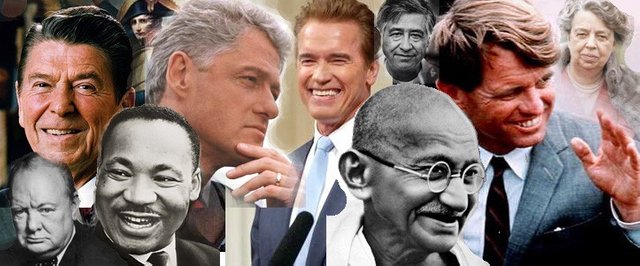WTF is Charisma and how do I get it? Personal Charisma vs. Charismatic Leadership
Personal Charisma vs. Charismatic Leadership
So, in the last article , I covered the history of charisma. It’s not particularly important for the story of it all, but it’s an interesting read (for me at least) and gives you a feel of what charisma meant in the olden days.

Neocharismatic Theories
Neo-charisma are theories within leadership that focus on “How can a leader inspire followers?”. If you think back on some of the great leaders through time, most of us will say that in some way or another, they have inspired us. Changed something within you. Made you do something you never thought you would do. This is where the recent leadership theories are heading, since leadership theories in the past didn’t cover this specific trait of leadership (Raes, 2017).
Neo-charismatic leadership can be defined as two specific perspectives of leadership; charismatic leadership and transformational leadership. Although they are similar in effect and the results they achieve, they are theoretically different (Antonakis et al., 2011). Transformational leadership is much broader and comes from the leader influencing using a developmental and rational focus, by intellectually stimulating followers and building on the individual (employee/follower) himself. This means that pure charismatic leadership is more ‘external’ and comes from the leader, maybe by creating a shared vision for the organization. Transformational leadership has a more ‘internal/individual’ focus, e.g. by building on the individual follower’s strengths or change the follower’s perspective individually.
Charismatic leadership is the form of leadership that is visionary (Raes, 2017). It is creating a vision of what you want to achieve or something you foresee in the near future. The vision is made believable by the leader, often through personal risk for the leader. Leaders that utilize this form of leadership are often sensitive to the followers needs. The vision comes from something, and this something appeals to followers. Something that the followers want, and often didn’t know they wanted. We often see unconventional behavior in leaders that utilize this form of leadership. They challenge the status quo. These leaders often go beyond what other people have done before. Because of this behavior, followers prescribe charisma to these leaders and buy into what they want to achieve.

Transformational leadership is when the leadership is when the leader, by behavior or example, manages to change something in the follower. This can be to change the employee’s perspective, ambition, objective etc. This means to transform something in the employees, maybe something that they didn’t know they wanted to achieve (Raes, 2017).
Transformational leadership is when a leader work together with the followers to identify change, while creating a shared vision for the company. Transformational leadership is led through inspiration and motivation. It’s goal is to enhance job performance through creating a connection to the employee’s sense of identity and the collective identity of the organization and the projects worked on. A transformational leader is a role model for his/her followers, getting eemployees to take greater ownership in their work. It is critical to understand strength and weaknesses of followers to enhance performance. (Bass, 1990)
Transformational leader behavior is focused on the individual follower. A common trait of transformational leadership is that the leader show great appreciation of the follower. The leader show that he/her care deeply for the employee’s wellbeing. The leader also inspires the employee to achieve higher work performance through ambitious goalsetting. The leader challenges the employee to go the extra mile through intellectual stimulation by setting high standards for the employee’s work. By setting ambitious goals that it is not evident that they will achieve, the leader pushes the employees to work towards a shared vision and effectively channeling a lot of people’s time and energy to achieve a shared goal. The most important trait of the leader is by setting an example. It is critical that the leader shows that he is working hard towards the same goal. The leader behavior must be credible in a way that it shows that he or she says what he/she does, shows care and appreciation towards the follower and is believable when setting and working towards the goals and vision.

So, there you have it! How charisma and leadership are connected. But there is a fat chance that, you the reader, are not a leader. I know, I know, someday. But does that mean you have no use for charisma in your life? That this is only relevant to the CEO’s and founders? Absolutely not! You must crawl before you can limp. Lets talk about the building blocks of charisma:
Personal Charisma
There is a certain distinction between charismatic leadership and what we call “personal charisma”. They are similar in the effect that they achieve, but different in the way they are contextualized. Charismatic leadership are used in a leader-follower- context, but a person can be seen as charismatic in a social context. Most leaders that utilize charismatic leadership, also has a strong foundation of personal charisma. In a way, personal charisma is the building blocks of charisma. This divide between charismatic leadership and personal charisma all comes down to context and setting of the social interactions between the individuals. In an organizational setting between leader and coworker or a public speaking context between speaker and audience, there will be more emphasis on charismatic leadership. In a setting where the interaction between individuals is “closer”, personal charisma will be the dominant variable.
Personal charisma is when someone has very high amounts of sophisticated social and emotional skill. This allows charismatic individuals to influence others on a deeper emotional level and form strong social bonds.

If you can’t handle me when I’m bulking, you don’t deserve me when I’m cut. — Marilyn Monbroe
The elements of personal charisma are (Riggio, 2010; Riggio, 1986):
Emotional expressiveness. The ability to express one’s feelings both spontaneously and genuinely. This is what allows you to affect the mood and emotions of others. This is the general ability of non-verbal expressivity of emotional states. A common saying is that charismatic people “light up the room” when they arrive. This is because of the ability to emotionally inspire or arouse by transmitting their own emotional states.
Emotional sensitivity. This is the ability to read and decode to other’s non-verbal communication. This skill is necessary to create strong emotional bonds with others by responding to their emotional state. Bill Clinton is a great example of this, and it is said that he had a gift to “make the person he was speaking to feel he or she was the only person in the room”.
Emotional control. The ability to regulate their emotional displays. This is a key ability of charismatic individuals. A great display of this skill came from Tony Robbins. Merely minutes from a big show, he received a letter that stated stat his business was going to into bankruptcy. It is safe to say that he was devastated. But he turned it off, and went on to go out on stage to inspire thousands of people that night.
Social expressiveness. Verbal communication skill is key to engage others in social interaction. Charismatic people, and nearly all charismatic leaders, are skilled in conversional and public speaking.
Social sensitivity. How to read and interpret social situations and how to listen to others, is an important ability to create social and emotional bonds.
Social Control. This can be interpreted as high level role-playing. The ability to fit in and connect with all sorts of people is a key ability of charismatic people. Persons skilled in Social Control have the ability to play various social roles and can easily take a particular stance or orientation in a discussion. They can adjust their personal behavior to fit with what they consider to be appropriate in any given social situation.
These are the key elements in charismatic behavior. While the more skilled one is in each category, it is also important to know how to balance the different skillsets. In other words, too high in one category and too low in another can be problematic. For example, if an individual is highly emotionally expressive, but lacks social control, will have trouble toning it down when it is inappropriate. Or reversed, if the individual is showing high emotional control without the expressivity, leads to a person who seem emotionally cold and distant.
Hope you liked it and had a great read!
Hi! I am a robot. I just upvoted you! I found similar content that readers might be interested in:
https://medium.com/@tomroa/charismatic-behavior-series-personal-charisma-vs-charismatic-leadership-53c323b38a93
For anyone wondering if I ripped someone off, I am the author of that article.
Hey @tommy.roadsneeze, great post! I enjoyed your content. Keep up the good work! It's always nice to see good content here on Steemit! Cheers :)